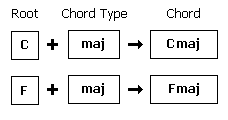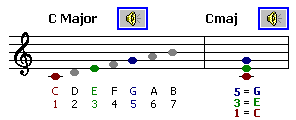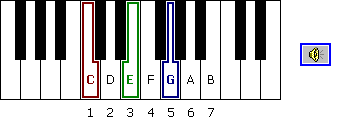(3.4) Building Chords
Chords are built from the combination of intervals formed by playing three or more different notes together.
There are many different chord types, and each one is defined by its unique formula or spelling, a combination of intervals (degrees) measured from the starting note (known as the root note or tonic note).
Let's take an example. A very common chord type is the major chord (maj for short) which has the formula shown below.

As you see, it contains the degrees 1, 3 and 5. In other words, these are the first, third and fifth notes of the Major scale with the same starting note.
When we assign a root note to a chord type, these degrees allow us to work out what the other notes are, and the chord type becomes a chord.

Let's see how this works for the Cmaj chord. The C root note tells us that we will be using the notes of the C Major scale. The maj chord type tells us to take the first, third and fifth notes from this scale.

We have now worked out that the Cmaj chord contains the notes C, E and G. Here's how it appears on the piano.

The maj chord and the Major scale are strongly related to each other, and both are fundamental elements of music. Notice the difference in notation between the chord (Cmaj) and scale (C Major).












